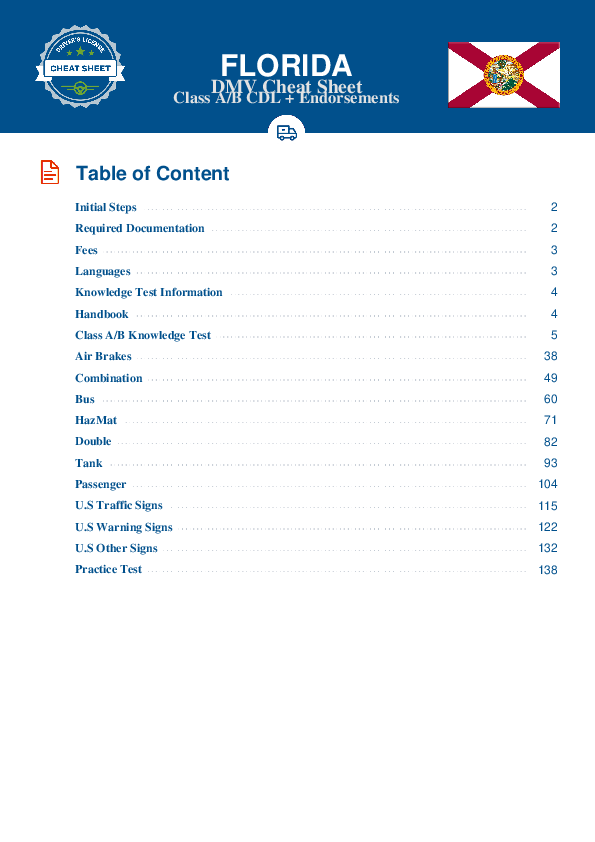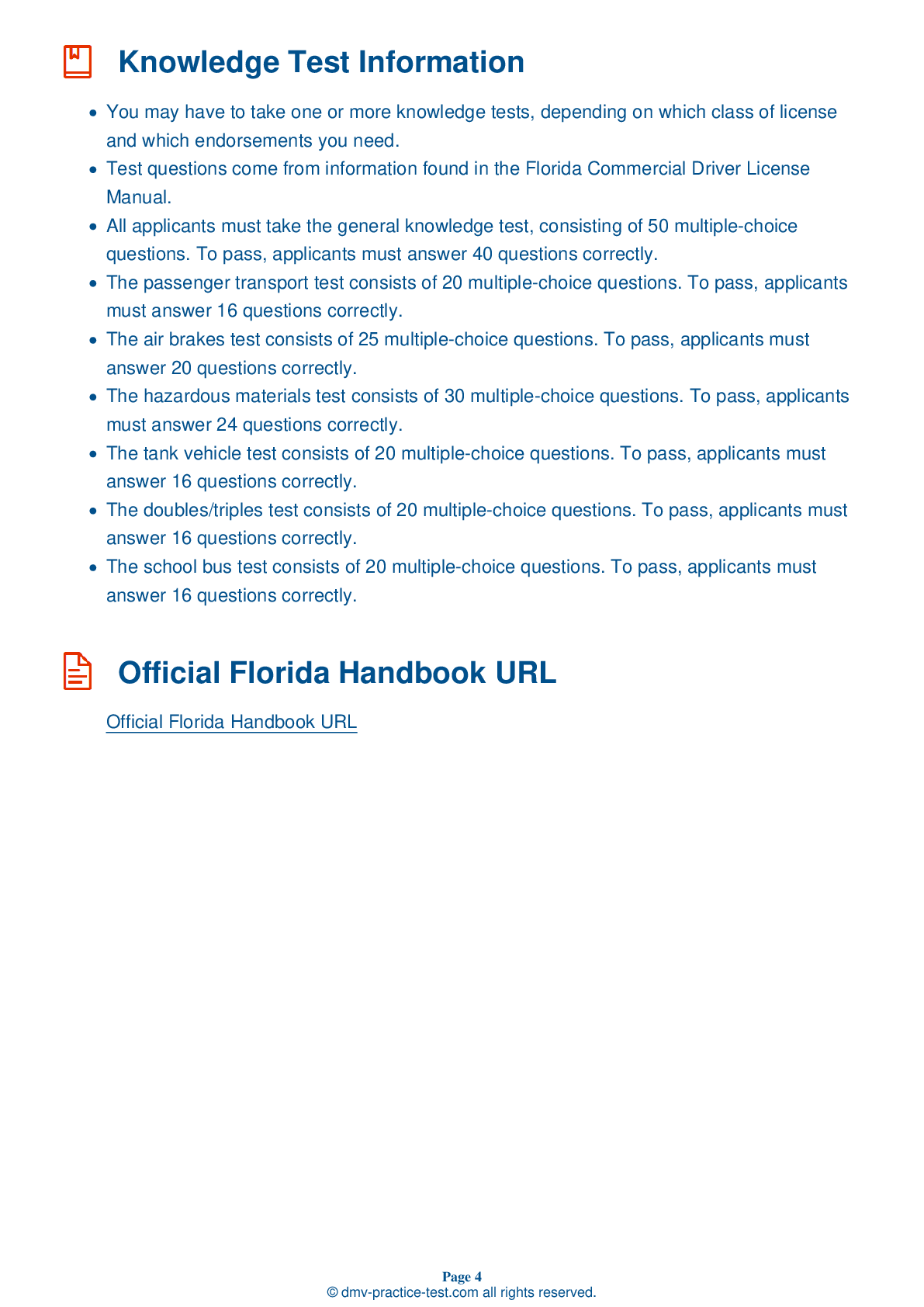Air Brakes #2
Air Brakes Endorsement Test | Florida 2025 #2 Page 2 of 4
Train for FREE online with our Florida CDL air brake test. The official exam test consists of several obligatory parts, with all of them checking your knowledge of different blocks of road rules. If you need to obtain a FL Class A/Class B driver license in 2025, practice as much as possible. Free sample tests published on our website will help you check and improve your knowledge and boost your grades. Please bear in mind that the requirements for CDL may vary from state to state.
25
20
20
7 . Foundation brakes are used:
At each wheel.
Foundation brakes are used at each wheel. The most common type is the S-cam drum brake.
8 . If using air tanks with manually operated drains, how often should you drain the tanks?
Once every 3,000 miles
To prevent the build up of oil and water in a vehicle's air tanks, manually operated air tank drains should be used at the end of each day of driving.
9 . What color light indicates a vehicle's ABS is not working?
On vehicles with Anti-Lock Braking Systems (ABS), yellow malfunction lamps alert the driver to ABS malfunction.
10 . What do anti-lock brakes do?
Prevent a vehicle from accelerating while traveling downhill
The function of an Anti-Lock Braking System (ABS) is to prevent the vehicle's wheels from locking up from hard brake application.
11 . Before driving a vehicle with a dual air brake system, you must wait for the air compressor to build a minimum of ____ in both the primary and secondary systems.
100 psi
Before driving a vehicle with a dual air brake system, you should wait for the air compressor to build up at least 100 psi in both the primary and secondary systems.
12 . Before driving a vehicle with air brakes, you should ensure that the spring brakes come on automatically when:
Driving uphill.
Before driving a vehicle with air brakes, you should ensure that the spring brakes come on automatically when air tank pressure falls to a level between 20 and 45 psi. You can do this by chocking the wheels and releasing air from the braking system by stepping on and off the brake pedal. Once the pressure drops to an unsafe level, the parking brake valve should pop out and spring brakes should come on.
2025 Florida | Frequently Asked Questions
In Florida, a Commercial Driver's License (CDL) Class B is a type of license required to operate vehicles with a Gross Vehicle Weight Rating (GVWR) of more than 26,000 pounds. It also allows the holder to tow vehicles that weigh less than 10,000 pounds. This includes buses, dump trucks, delivery trucks, and straight trucks.
A Class B CDL license in Florida allows the holder to operate single vehicles with a Gross Vehicle Weight Rating (GVWR) of 26,001 pounds or more, or any such vehicle towing another not in excess of 10,000 pounds. This includes vehicles like city buses, tourist buses, segmented buses, delivery trucks, dump trucks, and utility trucks.
To acquire a Class B CDL license in Florida, an applicant must be at least 18 years old (21 for interstate driving), possess a valid Florida driver's license, pass a vision test, and successfully complete the General Knowledge test. Additionally, an applicant must pass the pre-trip, basic controls and road test for the desired vehicle. A medical examination report is also required.
In Florida, you must be at least 18 years old to qualify for a Class B Commercial Driver's License (CDL) for intrastate driving (within Florida only). However, you must be 21 years or older to qualify for interstate driving (across state lines or transporting hazardous materials).
Specific endorsements are not necessary for a Class B CDL license, but they can broaden your driving capabilities. Endorsements allow you to drive certain types of vehicles or transport specific goods. For example, a passenger or school bus endorsement allows you to drive large buses, while a hazardous materials endorsement allows you to transport hazardous materials.
The Class B CDL skills assessment in Florida includes three parts: a pre-trip inspection, a basic vehicle control test, and an on-road driving test. The pre-trip inspection tests your knowledge on vehicle safety, the basic vehicle control test checks your ability to maneuver the vehicle, and the on-road driving test assesses your practical driving skills in various traffic situations.
Yes, Class B CDL license holders in Florida are restricted to driving single vehicles with a gross vehicle weight rating (GVWR) of 26,001 pounds or more, or a towing vehicle not exceeding 10,000 pounds GVWR. They cannot operate Class A vehicles unless they upgrade their license. Also, without specific endorsements, they cannot transport passengers or hazardous materials.
In Florida, the written Class B CDL test is primarily offered in English. However, some locations may provide the test in Spanish. It's important to note that federal regulations require all commercial drivers to understand and read English well enough to converse with the general public, understand traffic signs and signals, respond to official inquiries, and make entries on reports and records.
Yes, you can request test accommodations for the Florida Class B CDL written exam if you have a disability. The Florida Department of Highway Safety and Motor Vehicles (DHSMV) complies with the Americans with Disabilities Act (ADA) and provides modifications or aids to help individuals with disabilities take the test. However, you must provide documentation supporting your need for accommodation.
If you don't pass the Class B CDL written test in Florida, you can retake it. However, you must wait until the next business day to do so. If you fail the test three times, you will need to complete a state-approved driver education course before attempting the test again. Keep in mind that each retest comes with an additional fee.



